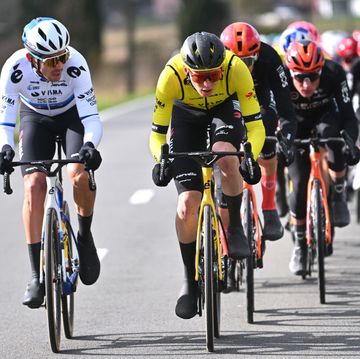The first-ever U23 women’s race at the 2016 Cyclocross World Championships in Zolder, Belgium, made plenty of headlines this weekend—but not for the reasons cycling fans would like. While the event was a great step forward for equality in women’s pro cycling, it also brought some scandal: UCI officials announced that they had confiscated a racer’s bike in the first confirmed instance of mechanical doping.
Mechanical doping, for those unfamiliar, generally refers to hiding a small motor in a bike’s frame or rear hub. Rumors of mechanical doping have bounced around for several years, and the UCI has previously acknowledged that it suspected some riders had cheated that way, but last weekend brought the first confirmed case.
The bike in question belonged to the race favorite, 19-year-old Femke Van den Driessche of Belgium. Prior to this race, officials had used bulky X-ray equipment to scan bikes, or physically disassembled the bottom bracket of bikes in question to examine them for motors. But at Zolder, the organization brought out a new device, a computer approximately the size of an iPad that can detect radio frequencies emitted by a motor. When the computer registered signs of a possible motor in Van den Driessche's bike, officials reportedly removed the seatpost to find wires sticking out. This year, UCI officials worked the pits during the event, rather than checking bikes prior to and after the race, as they have previously done. “[The UCI official] checked through bikes from most of the countries,” said Aspire Racing mechanic Tom Hopper, adding that he was surprised to see the UCI official in the pits, working among mechanics who were scrambling to take care of muddy race bikes.
RELATED: How Does Mechanical Doping Work?
Van den Driessche claims the affair was an unintentional mix up. She told VRT Sport, she says, "I had honestly nothing to do with it. There was nothing wrong with the bike that I raced on. I’ve done nothing wrong,” adding that the bike belongs to her brother's friend. Spectators reported that partway through the race, Van den Driessche was spotted walking with her bike on course as if she had a mechanical problem. Then, she climbed over the fence with her bike, DNFing the race and pedaling away.
Mechanical doping can, at the moment, result in a six-month suspension plus a fine of between $20,000 and $200,000—though some riders are calling for a more stringent sentence, even going so far as to say a lifetime ban is appropriate,
Kaitie Antonneau of Cannondale-CyclocrossWorld raced in the women's elite race at Worlds and says, “The whole thing really makes me angry. It's very disappointing.” Also frustrating, she notes, is that the historic introduction of the women's U23 field was entirely overshadowed. “I understand the motor in the bicycle is an issue that needs to be addressed, but it's frustrating that this extremely negative situation overshadowed all of the women who worked so hard.”
Details of this incident are still emerging, but mechanical doping is going to be a hot-button topic in cycling in the upcoming road and mountain bike seasons.













